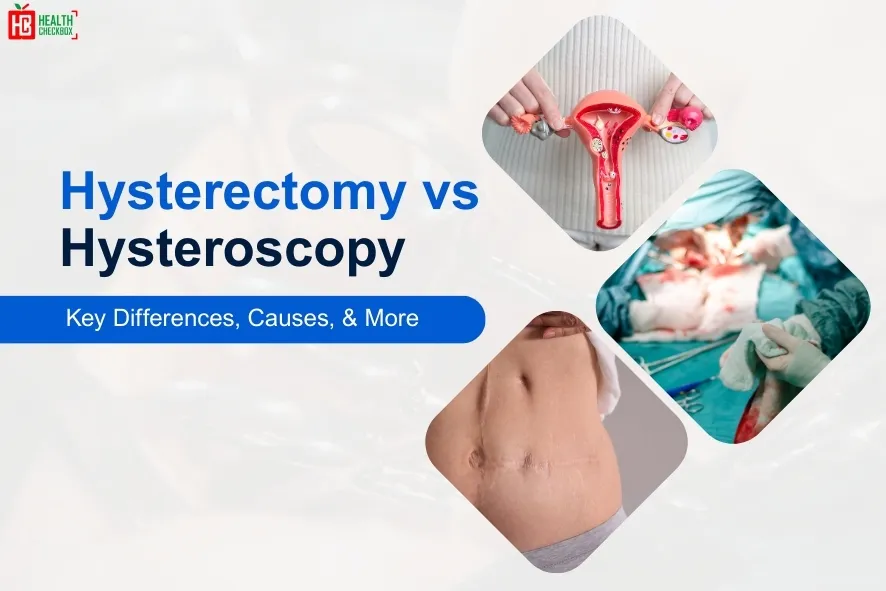If a woman is facing a gynecological issue, she might be exploring various treatments for it. Many treatments may sound similar but differ significantly in terms of their functionality and target. Hysterectomy treatment and hysteroscopy treatment are one of them. However, in hysterectomy vs hysteroscopy, which one is suitable for you depends entirely on the issues you are suffering from. In this blog, we will understand the basic difference between them and their types, alternatives, and complications.
What is a Hysterectomy?
The removal of the uterus from the woman’s body is known as a hysterectomy. This is because of the growth of disease or damage in the uterus. Sometimes, surgeons also remove ovaries, fallopian tubes, and cervix as per the need. This process is mostly recommended for conditions like endometriosis, uterine fibroids, abnormal bleeding, chronic pelvic pain, uterine prolapse, and also in some cancers.
What is Hysteroscopy?
Hysteroscopy Treatment is a minimally invasive procedure to determine the issue in the uterus. A thin tube is inserted in the uterus via the vagina by making a small incision, known as a hysteroscope. This allows the doctors to see through without making any incisions. Some smaller issues can also be treated with this hysterectoscope and some microrobotics equipment.
Types of Hysterectomy Procedures
Types of surgery for hysterectomy depend on multiple things, condition of patients, the type of infection, or medical needs. Some major types of hysterectomy treatments are as below:
Vaginal Hysterectomy Treatment
The uterus is removed from the vaginal part, which leaves no marks of incision or any scar. This helps the patient to recover faster and with almost no complications.
Robotic Hysterectomy Treatment
Surgery is performed using a minimal incision with the help of computer-assisted equipment or robotic equipment. Due to the smaller incision, the loss of blood is less, and the patient recovers faster.
Laparoscopic Hysterectomy
A camera is inserted from a small incision along with minimal surgical equipment, whereas in an abdominal hysterectomy, an incision is made in the lower abdomen is of a larger size, in some complex cases.
Types of Hysteroscopy Procedures
There are mainly two types of hysteroscopy as below:
Diagnostic Hysteroscopy
To examine the uterus from inside, to identify any issues or concerning problems. A small lighted tube is inserted by making a minimal incision.
Operative Hysteroscopy
After examination, if there is a problem that can be treated without any major surgery, minimal surgical robotic instruments are inserted through the same incision to treat the issue.
Alternatives to Hysterectomy vs Hysteroscopy
Before finalising any treatment, a patient should discuss the possible alternatives to hysterectomy with their medical team. There are many options, like endometrial ablation, myomectomy, uterine artery embolization, and hormone therapy are used to manage the symptoms of occurring problems. These alternatives are best for women who wish to conceive a baby later or to avoid major surgery.
If we talk about hysteroscopy, there are limited alternatives to this treatment. You can do an ultrasound scan and a biopsy (by using a tiny tube), most doctors recommend an ultrasound.
Recovery and Aftercare in Hysterectomy vs Hysteroscopy
Both hysterectomy and hysteroscopy have different recovery times and aftercare, because of the difference in their surgical approach.
Hysterectomy
- Recovery Time: Hysterectomy recovery time depends on various factors, but the major one is the type of surgery. Vaginal or laparoscopic procedures may take 4-5 weeks, while an abdominal hysterectomy takes 7-9 weeks to recover completely. Patient must avoid high-impact activities and sexual intercourse as advised by the surgeon.
- Aftercare or Post Surgery: Hysterectomy aftercare is essential for healing faster and smoothly. Don’t skip follow-up meetings with the doctor, and increase the physical activities gradually. Emotional support and rest are very important in the initial weeks of recovery.
- Diet and Food: Nutrients also play a major role in healing. There are more than 10 hysterectomy recovery foods, including nuts, legumes, fish, etc. These foods support the immune system of the body and help in healing faster. Also helps in reducing complications like constipation after surgery.
Hysteroscopy
- Recovery Time: Most people recover from this in just 2 to 3 days. Although full recovery takes around two weeks.
- Aftercare: Avoid driving for the next 24 hours, and try to take a bed rest, because you may experience mild cramps and shoulder pain.
- Food Intakes: If feeling nauseous, a person must consume a low-fat food. High-nutrition food will also help to recover faster.
Potential Complications
Both hysterectomy and hysterocopy are considered safe and have positive outcomes in most cases. However, every surgery or treatment has complications too. That’s why people must be aware of the long-term complications of hysterectomy. Some of the complications are as below:
Hysterectomy Risks:
- Early menopause, if both ovaries are removed.
- The risk of heart-related disease increases
- Involuntary urination
- Dysfunction in sexual functionality
- Prolapse of the pelvic organ
- Psychological effects
Hysteroscopy Risks:
- Infection
- Bleeding
- Discharge
Discussing the post-surgery complications and related symptoms with your medical provider can help them develop a better plan for you.
Finding Quality Care in India
India is one of the leading medical destinations for all types of surgeries. At a competitive cost with the best-in-class service and treatments. There are some best hysterectomy hospitals in India, like Apollo, Max, Fortis, Medanta, etc. These highly specialised hospitals have well-equipped robotics, experienced surgeons, and trained staff. And a best-in-class post-surgery aftercare.
On the other hand, choosing the best hysterectomy surgeon in India is also important for the most positive result. Finding a surgeon may require a little research. You can check for the success rate of surgeries done by that surgeon, the patient’s review, and certifications.
Leading surgeons, especially in metro cities like Delhi, Chennai, Mumbai, Ahmedabad, and Bangalore, are trained in robotics techniques. And they do have experience with multiple surgeries also.
Conclusion
Deciding between hysterectomy vs hysteroscopy depends totally on several factors. Like age, the condition of the patient, in future fertility plans, or overall health condition. Hysterectomy offers an excellent treatment without removing the uterus or any incision. But it is limited to only some cases.
For wider coverage, a patient has to explore the options of a hysterectomy. Hysterectomy is a surgical procedure in which a complete uterus is completely removed or a partial uterus is removed. Patients take more time to recover after this. It is advised to consult the hospital consultants for a better decision.

